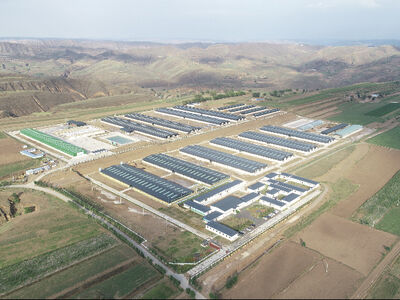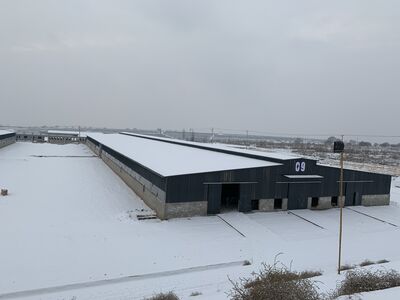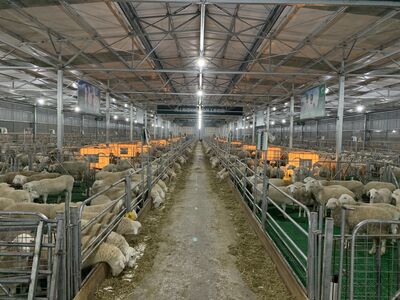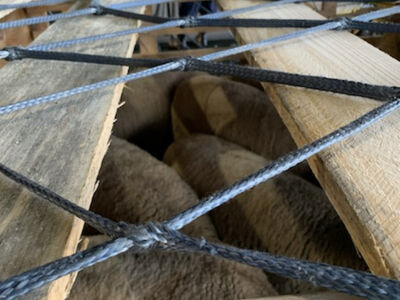Courtesy of Russ Davis, Ceva Animal Health
Life often gives us the most unexpected opportunities when we least expect them. One of my current projects is a large-scale breeding operation in China, 50,000 breeding ewes (under cover) in a vertically integrated operation. The farm features a breeding system (both natural and assisted), a lamb finishing feedlot for those lambs not required for breeding improvement/replacement, composting systems to manage the manure produced as well as greenhouses to feed all the workers. All the feed for silage is grown locally by contributing villages as a part of the poverty reduction scheme of China and an onsite abattoir is being constructed.
I became involved in this project in the most obscure way, I was invited to speak at an industry conference, then I was approached after my presentation to see if I would be available to travel to China to provide training on a new program. It was very short notice, due to leave in 10 days, but coincided with the cancellation of a week in my calendar. There were some hectic visa applications, flights booked, approvals gained and I was off to China.
For the next 10 days we would give two to three presentations a day, through interpreters, with audiences from universities through to peasant farmers with the requirement to rapidly adapt our presentations to suit the audience, all the while planning for this new project of 50,000 breeding ewes undercover, providing facility design, systems and a genetic improvement plans, new genetics, cross breeding programs and plans to increase the production capabilities of the indigenous breed the Hu.
Beginning the planning process
We started this plan by inspecting all the current facilities and all the current sheep and then starting the process of classing the sheep. This was somewhat difficult as there are no facilities in China as we have them in Australia, no real yards, no drafting races, nothing that we would expect on a farm as far as infrastructure goes. So us Australians got busy and went to the scrapheap and built a set of yards, a makeshift drafting race and began the process not only of drafting the sheep but actually teaching the sheep to move - some had never left a pen - and how to run through a race. Using Chinese farmhands that stood in all the wrong spots, and made all the wrong noises, we got through it, 8000 ewes through makeshift draft, (multiple times) working long into the night at minus 20 degrees to even up the lines of the sheep .
At this stage we had the different small farm’s flocks (to be consolidated into the new purpose-built facility) organised into age, conformation and selected the core genetic group ready for the next phase. One thing the stands out in China is the speed at which things move and of which buildings and facilities can be built. We visited the Greenfield site with earth moving equipment moving everywhere and four months later moved sheep into the completed site - quite unbelievable.
The next task was to increase the holdings of sheep so we packed up an entourage and off we went on a sheep buying tour of southern China, naively thinking this would be conducted similar to how I would buy sheep in Australia. I was in for a very quick education . The first time we visited a farm I expected the sheep to be sorted into what we were looking for, however this was not the case, I was simply given access to the entire farm and told to select what I wanted one by one pen by pen by walking through the pens and marking an animal and then a worker would come along and pick it up out of the pen this was to be repeated on every farm that we visited until I had purchased the required amount - 16,000 ewes.
One of the highlights was visiting the Hu stud that had won champion Hu ram of China that year. Upon inspecting the Rams that they had selected for us I had rejected all but one this caused some consternation with the group, however after much discussion they relented and allowed me to walk through the rest of the farm where I selected 5 more rams including the Chinese champion, this caused a bit of a laugh amongst the group they all agreed I had a good eye but alas we didn’t get the champion ram.
With the sheep now selected, sorted and transported to the new facility the real work started, and over the next year we worked out the challenges that we would truly face in China. This is where we started to see similarities between China and Australia and where the challenges lie in the interface between the theoretical knowledge and the practical application for systems and process in an agricultural enterprise
It was not unusual to be working with professorial level local experts who knew the ins and outs of silage making at a theoretical level but couldn't actually get it in the pit, and we would see perfectly formulated rations not fit for purpose. One of the most common challenges we faced was all the rations seemed to be designed by a swine nutritionist, and therefore the feed was constantly over cut and over chopped. The grain content, mostly corn, was ground to polenta and the sheep suffered clinical or subclinical acidosis constantly. Iit took almost two years to convince our own team to not grind the grain and to leave roughage 50 to 80 millimetres long to get the best feeding results.
The next major hurdle we faced was lambing down, we lambed down 21,000 ewes all within three weeks in minus 23 degrees temperatures. The shed design worked well, air flow was excellent and air quality was very good, the overnight temperatures in the sheds hovered around zero. I was however concerned about small lambs, for these we designed lamb incubators at an industrial level using thousand litres shuttles. I calculated the required temperature based on the volume of the shuttle and the size of the lamb and their thermal regulation. We needed 2 x 50 Watt lamps to maintain constant temperature, so if 2 x 50 watts did the job, but our Chinese colleagues having never seen this system decided that surely 2x 150 Watt lamps would be better, the lambs would be even warmer!! Once we sorted that out, we stopped the overheating problem and went back to the original design specs.
We have been heavily involved in training staff, ensuring that we introduce better animal welfare programs into the program, ensuring quarantine protocols are observed with introduced stock and ensuring animal health treatments are being recorded. Reproduction programming has been a key measurable in this project and we have introduced a three lambings in two years program, progressing to five lambings in three years. This is not without challenges even with good facilities. It is not uncommon to have ewes moved into new pens without recording movement, sometimes by the cleaner to make it easier to clean the pens! We have pioneered the use of Regulin, light programs and key time feeding to drive conception and lamb survivability and in a short period of operation are seen as the leaders in establishing effective animal welfare management.
While we have been selecting ewes and rams in Australia and collecting semen and embryos for export, we have also selected and freighted (by air) live sheep for our genetic improvement program. There are many examples of genetics being exported to China that have not proven fit for purpose, this is not, in my opinion because they are poor genetics but rather a disconnect from buyer to seller in what they are trying to achieve. With controlled and measured cross breeding we have already achieved, in a short time, significant improvement on meat yields. With the live imports we have seen growth in Hu crossbreeds that has never before been achieved. With the ability to measure results, consistently and on a large scale we have been able to determine which cross breed will be the most successful. We are comparing five different breeds in this crossbreeding program, at this stage two breeds are showing a significant advantage on lamb survival and in early weight gain. Poll Dorset is in the top two breeds, while there is still much work to do, developing indexes and using data to determine the next steps I can say that the combination of Hu and Poll Dorset genetics promises a bright future for future exports.



